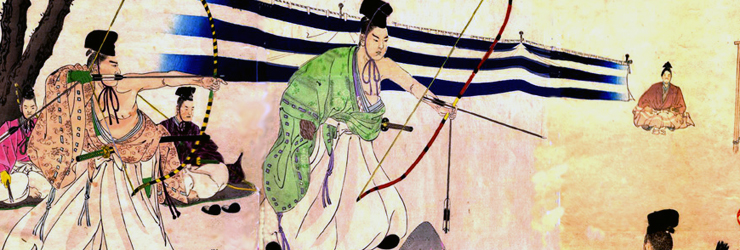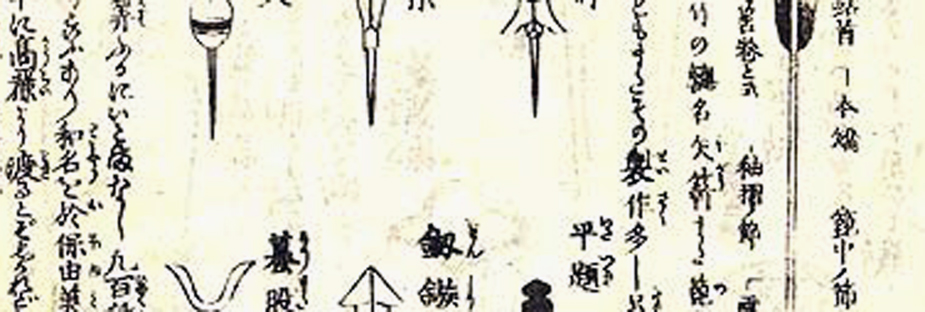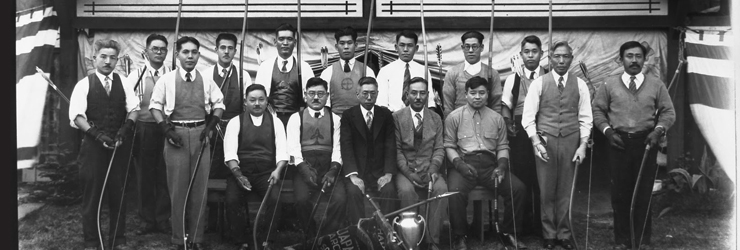The beginning of archery in Japan is, as elsewhere, pre-historical. The first images picturing the distinct Japanese asymmetrical longbow are from the Yayoi period (ca. 500 BC-300 AD). The first written document describing Japanese archery is the Chinese chronicle Weishu (dated around 297 AD), which tells how in the Japanese isles people use “a wooden bow that is short from the bottom and long from the top.”[3] During these times the bow began to be used in warfare in addition to hunting. Later, the ceremonial use of a bow was adopted from China and continued in Japan after it had ended in China. The composite technique of bow manufacture, by gluing together horn, wood, and animal sinew, was also imported from China.
Emergence
The changing of society and the military class (the samurai) taking power at the end of the first millennium created a requirement for education in archery. This led to the birth of the first kyudo ryha (style), the Henmi-ry, founded by Henmi Kiyomitsu in the 12th century.[4] The Takeda-ry and the mounted archery school Ogasawara-ry were later founded by his descendants. The need for archers grew dramatically during the Genpei War (1180-1185) and as a result the founder of the Ogasawara-ry, Ogasawara Nagakiyo, began teaching yabusame (mounted archery).
Civil war
From the 15th to the 16th century Japan was ravaged by civil war. In the latter part of the 15th century Heki Danj Masatsugu revolutionized archery with his new and accurate approach called hi, kan, ch (fly, pierce, center), and his footman’s archery spread rapidly. Many new schools were formed, some of which, such as Heki-ry Chikurin-ha, Heki-ry Sekka-ha and Heki-ry Insai-ha, remain today.
~1500s~
The yumi (Japanese bow) as a weapon of war began its decline after the Portuguese arrived in Japan in 1543 bringing firearms with them in the form of the matchlock.[5] The Japanese soon started to manufacture their own version of the matchlock called tanegashima and eventually the tanegashima and the yari (spear) became the weapons of choice over the yumi. The yumi as a weapon was used alongside the tanegashima for a period of time because of its longer reach, accuracy and especially because it had a rate of fire 30-40 times faster. The tanegashima however did not require the same amount of training as a yumi, allowing Oda Nobunaga’s army consisting mainly of farmers armed with tanegashima to annihilate a traditional samurai archer cavalry in a single battle in 1575.
~1600s on~
During the Tokugawa period (1603-1868) Japan was turned inward as a hierarchical caste society in which the samurai were at the top. There was an extended era of peace during which the samurai moved to administrative duty, although the traditional fighting skills were still esteemed. During this period archery became a “voluntary” skill, practiced partly in the court in ceremonial form, partly as different kinds of competition. Archery spread also outside the warrior class. The samurai were affected by the straightforward philosophy and aim for self-control in Zen Buddhism that was introduced by Chinese monks. Earlier archery had been called kyjutsu, the skill of bow, but monks acting even as martial arts teachers led to creation of a new concept: kyd.
~Revival~
During the changes brought by Japan opening up to the outside world at the beginning of the Meiji era (1868-1912), the samurai lost their position. Therefore, all martial arts, including kyudo, saw a significant decrease in instruction and appreciation. In 1896, a group of kyudo-masters gathered to save traditional archery. Honda Toshizane, the kyudo-teacher for the Imperial University of Tokyo, merged the war and ceremonial shooting styles, creating a hybrid called Honda-ry. However, it took until 1949 before the All Japanese Kyudo Federation (ANKF, jap. Zen Nihon Kyd Renmei) was formed. Guidelines published in the 1953 kyudo kyohon define how, in a competition or graduation, archers from different schools can shoot together in unified form.



